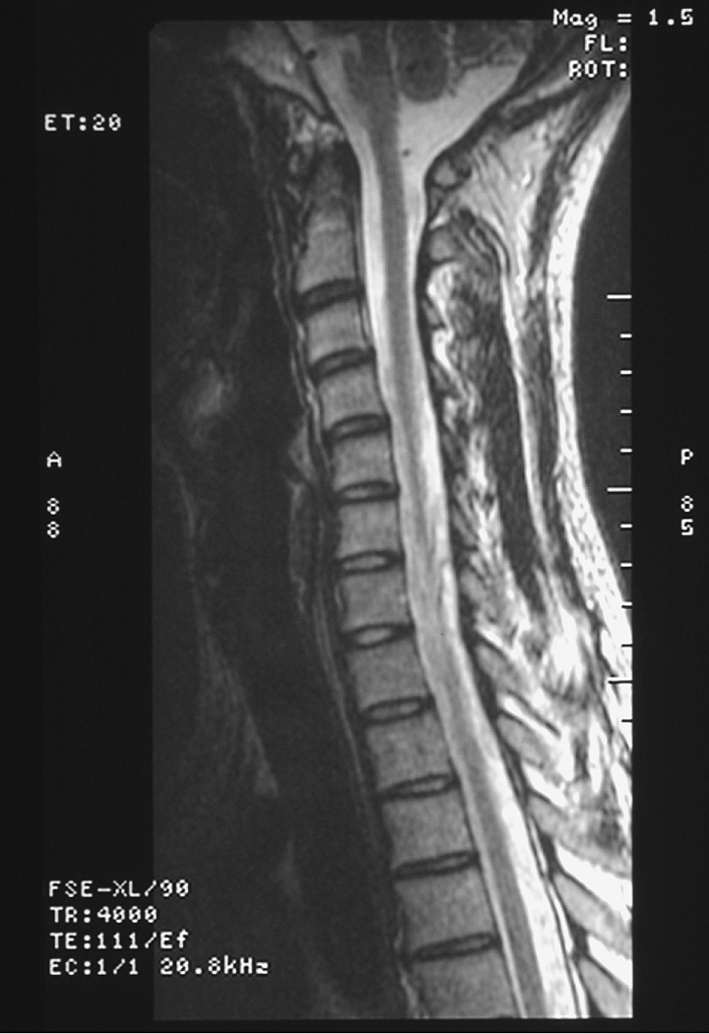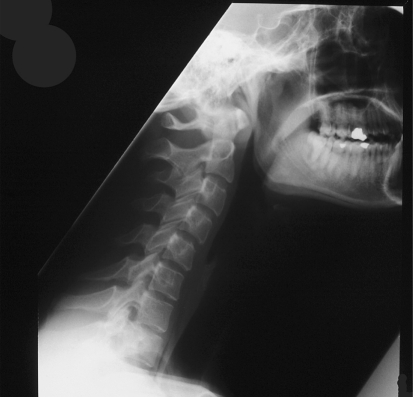Abstract
Whiplash injuries from motor vehicle accidents are very common. The usual presentation and course of this condition normally results in resolution of symptoms within a few weeks. Brachial plexus traction injuries without any bone or joint lesion of the cervical spine have been reported before. We report a case where a gentleman was involved in a rear end vehicle collision, sustained a whiplash injury and was later found to have a long thoracic nerve palsy and spinal accessory nerve palsy. Although isolated injuries of both nerves following a whiplash injury have been reported, combined injury of the two nerves following a whiplash injury is very uncommon and is being reported for the first time.
Keywords: Whiplash, Injury, Nerves, Long thoracic, Spinal accessory
Introduction
Whiplash injuries from motor vehicle accidents are very common. The usual presentation and course of this condition normally results in resolution of symptoms within a few weeks [4].
The incidence of whiplash injuries has increased dramatically [2]. The presumed damage in most cases is a soft tissue injury but its exact nature remains uncertain. Investigations such as X-rays and MRI scans are usually normal [8].
Nearly 40% of patients have persistent discomfort and 10% are unable to return to work. Those with diffuse numbness, pain and weakness of the neck, shoulder and upper limbs are a challenge to diagnose and treat [6].
Some patients with whiplash injury appear to have irritation of the brachial plexus, an unusual autonomic status, peripheral nerve dysfunction and psychological problems [5].
Brachial plexus traction injuries without any bone or joint lesion of the cervical spine have been previously reported. We report a case where a gentleman was involved in a rear end automobile collision and sustained a whiplash injury, he was diagnosed with a long thoracic nerve palsy (LTNP) and spinal accessory nerve palsy (SANP). Although isolated injuries of both the nerves following a whiplash injury have been reported, an extensive literature search has shown that a combined injury of the two nerves following a whiplash injury has never been reported before.
Case report
A 30-year-old right hand man was referred by his family physician with the chief complaints of pain in his left shoulder, numbness in the left arm and weakness of his left grip. Previously he had been involved in a RTA while travelling in a bus some 6 months previously. At the time of the accident, he was seated and forward facing in a single decker bus which was stationary. The bus was hit from behind by a medium sized milk float travelling at about 20 mph. The patient felt a jolt and immediate left sided neck pain following which he immediately attended his local hospital. He was examined but no mention was made of any neurological deficit. An X-ray was done of his cervical spine, which was found to be normal. A diagnosis of whiplash injury was made and he was discharged with physiotherapy follow-up and analgesics.
There was a good recovery of his neck pain with physiotherapy and analgesics but he continued to complain of pain in his left shoulder, numbness in his left arm and weakness of his left grip, which kept him off work.
Some 4 months following his accident, the treating physiotherapist felt the need of an upper limb specialist’s opinion, as his left shoulder symptoms were not improving. Upon presentation to the upper limb clinic his chief complaint was pain in his left shoulder aggravated on performing activities of daily living. The neck pain had reduced. On inspection there was winging of the left scapula. He had a full range of movements of the neck with no muscle spasm. Active movements resulted in discomfort in his left neck. Neurological examination revealed normal deep tendon reflexes in both arms and a weak grip of the left side.
His X-rays revealed flattening of normal cervical lordosis (Fig. 1). Magnetic Resonance Imaging was inconclusive and failed to reveal any abnormality (Fig. 2). He was referred for EMG and nerve conduction studies with a suspected stretch injury to his left brachial plexus.
Fig. 1.
Lateral cervical spine X-ray showing loss of normal cervical lordosis
Fig. 2.

MRI scan of cervical spine showing no abnormalities
The nerve conduction studies showed electrophysiological evidence of a left brachial plexus lesion. Concentric EMG sampling was done in the left deltoid, left infraspinatus, left biceps, left triceps, left trapezius and left serratus anterior muscles. Motor unit recruitment patterns were reduced in the left trapezius and left serratus anterior with definite evidence of denervation of both muscles.
Clinical examination revealed an altered shoulder profile, wasting over upper trapezius region and left scapular musculature, severe winging of scapula upon press up position off the wall and possible development of impingement in his left shoulder (Fig. 3). He was referred to physiotherapy with an aim to decrease pain both at rest and with functional activities, increase the strength of serratus anterior, trapezius and his left grip muscles.
Fig. 3.
Picture showing winging of left scapula
Discussion
Whiplash is normally considered to be a soft tissue injury of the neck, the diagnosis is made after fractures, dislocations and subluxations have been excluded. Classically, a whiplash injury is a hyperextension injury following a rear impact injury. However, soft tissue injuries can occur to the neck from frontal or side impacts [6].
The principal symptoms in whiplash are neck pain, stiffness and headache. Most symptoms resolve in a few weeks, however, a significant minority do develop a chronic condition.
Brachial plexus injuries following a whiplash injury are recognised with both long thoracic and spinal accessory nerve injuries reported separately [1, 3]. However, a combination of both nerve injuries following a whiplash injury is very uncommon.
The long thoracic nerve arises from the posterior aspects of C5, C6 and C7. Branches of C5 and C6 enter scalenus medius, unite in the muscle and emerge as a single trunk from its lateral border and pass down into the axilla. On the surface of serratus anterior this is then joined by the branch of C7 which has descended in front of scalenus medius. The long thoracic nerve passes down posteriorly to the midaxillary line and supplies the serratus anterior muscle segmentally [7].
The mechanisms of injury to this nerve may be as a result of viral illnesses, repetitive trauma or stretching, general anaesthesia, or surgical procedures [6]. In our case, the injury was most likely from a brachial plexus stretch at the time of the accident. The clinical result of this injury is winging of the scapulae without any muscular atrophy in the shoulder girdle. Most patients will have a great deal of disability due to this nerve injury. Functional loss will include the inability to lift or pull heavy objects, to play sports such as tennis or golf, and to perform tasks involving reaching above the shoulder level. This functional impairment results from the limited upward rotation of the scapulae and anterolateral positioning around the chest wall. These movements are essential to perform functions that demand elongation of the arm, such as pushing or pulling. With the loss of these three scapulae functions (i.e., fixation to the chest wall, rotation, and protraction), the upper limb will appear to hang from the scapulae with accentuating pain and a cosmetic deformity [5].
In the absence of a normal muscle force coupling with the trapezius, the scapula will medially rotate, wing-out, and its spine will be elevated. Long thoracic nerve injuries must be differentiated from spinal accessory nerve injuries, which can cause trapezius weakness along with some serratus anterior weakness. In long thoracic nerve lesions, winging of scapula is accentuated by forward flexion of the upper extremity. In contrast, the winging caused by spinal accessory nerve palsy is accentuated by abduction of the affected shoulder. Few cases of spinal accessory nerve injury have been reported secondary to whiplash trauma in the literature [1]. Our case is the first time a combined long thoracic and spinal accessory nerve injury following a whiplash trauma has been reported. Diagnosis of such brachial plexus injuries are very difficult to make in the first instance. They are normally missed on initial presentation and on immediate follow up.
Patients who have a long thoracic nerve injury often experience spontaneous recovery using conservative methods, but it may take up to 2 years for complete resolution of symptoms [8]. Initial management consists of cessation of overhead lifting and a program of physical therapy to improve range of motion by strengthening the serratus anterior, trapezius, levator scapulae, and rhomboids. Special bracing has also been used, but residual winging of the scapula may still be evident despite symptomatic improvement. Surgical intervention is rarely needed and should be delayed until clinical and electrodiagnostic evidence of nonrecovery exists after 6 months. In refractory cases, surgery often consists of muscle transfers to aid in scapular stabilization [5, 6].
Lesions of long thoracic nerve can be identified and differentiated from other clinical entities by careful history and physical examination. Electrodiagnostic studies can be used to confirm the clinical diagnosis and to follow recovery of the nerve [6].
A high index of suspicion for long thoracic and spinal accessory nerve injuries should be present following traction type injuries to cervical spine. Early diagnosis and treatment of these injuries may lead to more effective pain relief and a better functional outcome. However, when both nerves are injured, the time to recovery is inevitably longer then when one nerve alone is injured.
Contributor Information
N. Omar, Phone: +44-1254-263555
F. Alvi, Phone: +44-161-8606585, Email: alvi@btinternet.com
References
- 1.Bodack MP, Tunkel RS, Marini SG, Nagler W. Spinal accessory nerve palsy as a cause of pain after whiplash injury: case report. J Pain Symptom Manage. 1998;15(5):321–328. doi: 10.1016/S0885-3924(98)00008-6. [DOI] [PubMed] [Google Scholar]
- 2.Borchgrevink G, Smevik O, Haave I, Haraldseth O, Nordby A, Lereim I. MRI of cerebrum and cervical columna within 2 days after whiplash neck sprain injury. Injury. 1997;28(5–6):331–335. doi: 10.1016/S0020-1383(97)00027-2. [DOI] [PubMed] [Google Scholar]
- 3.Gupta V, Posner B. Trauma to the long thoracic nerve and associated scapula winging in a low-velocity rear-end automobile collision: case report. J Trauma. 2004;57(2):402–403. doi: 10.1097/01.TA.0000053468.19289.54. [DOI] [PubMed] [Google Scholar]
- 4.Hammacher ER, Werken C. Acute neck sprain: “whiplash” reappraised. Injury. 1996;27(7):463–466. doi: 10.1016/0020-1383(96)00064-2. [DOI] [PubMed] [Google Scholar]
- 5.Ide M, Ide J, Yamaga M, Takagi K. Symptoms and signs of irritation of brachial plexus in whiplash injuries. J Bone Joint Surg Br. 2001;83(2):226–229. doi: 10.1302/0301-620X.83B2.11094. [DOI] [PubMed] [Google Scholar]
- 6.Lovell ME, Galasko CS. Whiplash disorders—a review. Injury. 2002;33(2):97–101. doi: 10.1016/S0020-1383(01)00111-5. [DOI] [PubMed] [Google Scholar]
- 7.McMinn RMH. Last’s anatomy: regional and applied, 9th edn. Edinburgh: Churchill Livingstone; 1994. [Google Scholar]
- 8.Wiater JM, Flatow EL. Long thoracic nerve injury. Clin Orthop Relat Res. 1999;368:17–27. [PubMed] [Google Scholar]




